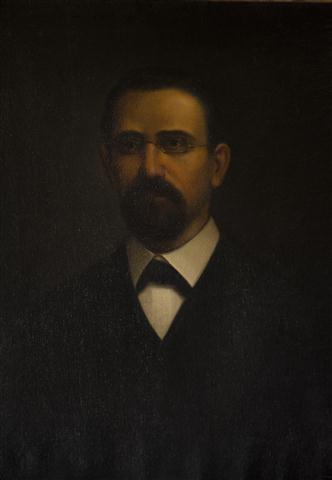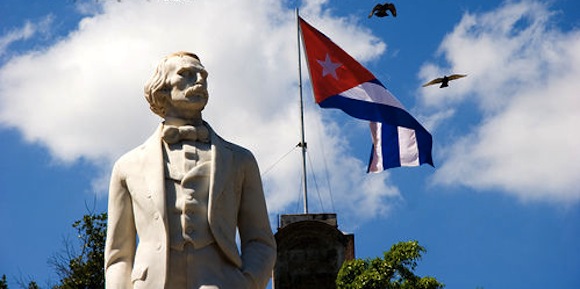Eusebio Leal Spengler ~ Historiador de la Ciudad de La Habana ~
A Flame Alive in our Memory
Dear General Harry Villegas; comrades from our Cuban Revolution Combatants’ Association; our liberators’ descendants Monsignor Carlos Manuel de Céspedes and Nancy de Céspedes (both descendants of the Father of the Cuban Nation); dear school children, fellow citizens and friends.
“It is necessary to place our trust in one person and put in a lot of effort to lift her onto our shoulders. I am in an exceptional situation, which should not be assessed by making historical comparisons, or else errors will be made. There is nothing like the war in Cuba. No public man has ever been in my situation. It is necessary to take something from everyone, and put it in a special mold to cast my figure, as no measure fits me and no complaint compares to mine.”
These remarks by the Father of the Cuban Nation on 23 June 1872 in Pozo Blanco, near Holguín, explain at that moment, the difficulties the revolution was undergoing that year – one of the hardest after La Demajagua Cry.
Today our ceremony is being held on the 9th, out of respect for Bayamo – a heroic city for so many reasons –, so that the solemn ceremony is held there tomorrow October 10th in the ruins of La Demajagua sugar mill – a National Monument –, where it was nature that erected the memories of the events taking place on that day [of 1868].
Mention must be made today of the fact that someone who accompanied us for years on this ceremony, Revolution Commander Juan Almeida Bosque, is no longer with us. Let us lift up our thoughts to him, to his austerity, his sense of duty, which led him to join us every year (especially last year) at this same site, even when he was in poor health. The image of that day is still alive in our memory. That is why this ceremony is also especially dedicated to him. Because there was only one Revolution, as Commander in Chief Fidel Castro once explained; the Revolution started by the Father of the Cuban Nation on October 10th has reached out in time.
It is essential that we do not tell the story of what we have done, and focus on what our founding fathers did; those who had to resort to a sublime act of violence, to fight against an unfair system, and throw down the gauntlet to their opponent in La Demajagua and Yara.
Yara is a resounding and short name, after which the revolutionary movement was subsequently named, as were many girls in Cuba and other parts of our America. Yara meant challenge, courage, perseverance, reluctance to surrender to nature’s adversities or those imposed by the enemy’s superiority.
Céspedes was not a father by accident – or a natural father – he is our people’s essential and legitimate father. It was he who started, and devised a plan [for the uprising]. It was he who conspired in silence for many years; abandoning privileges he enjoyed from childbirth, potential social standing and relations, trips … and he who was abandoned for the fate of the people, who became his own, and in whose mirror he saw himself. Although he was not alone, after his cry at La Demajagua; as well as those who had the courage to gather that morning, others came from surrounding regions in eastern Cuba, overlooking Manzanillo City on one side, and Bayamo on the other; the Gulf viewed from the sugar mill and Sierra Maestra mountains – where a long episode of the first and last battles was fought.
Céspedes was a hero and martyr of the revolution that he organized. He made the ultimate sacrifice, without hesitation – ignoring any human feelings he may have had about abandoning the fight on account of such things as envy, misery and triviality. He was practically cornered in that place – San Lorenzo – which has been preserved by nature and has not changed much ever since. That place became a symbol. The stone on which his body fell is the bloody altar where Cuba sacrificed its first hero, to gain the right to hold its head high and look to the future, in the belief that it was essential to work and struggle to make this possible.
On that day – 27th February – when his life was cut short, his wife and children were far away, although another son stayed in Cuba to preserve his memory, but he arrived in the camp when his father’s body had already been removed. Others remained as a symbol of his lineage – descendants who were born in the middle of tribulations, of a society dying amid a duel between virtue and passion, a battle between truth and time.
Céspedes was a symbol of nature and the human condition, but a symbol in whose rare virtue and deepest fiber was the future image of Cubanness, and timelessness of future generations to which he dedicated his last thoughts.
In the Flag Room that you are about to visit, there is a flame burning in memory of tens of thousands of Cubans who died fighting for Cuba’s freedom and independence following Céspedes’ mandate. The two wreaths that were sent today, by Commander in Chief Fidel Castro and President General Raúl Castro Ruz, have been laid across the flame as proof of undying and ever-growing devotion, which is the foundation for future peace and prosperity. We need to work hard and patiently breaking old molds – as Céspedes did -, sometimes doing away with things that seemed to be appropriate once, but not anymore. And, as a possible example, we should look at how we have evolved from 10 October [1868] to 1st January 1959, up to this 9 October 2009, on the 141st anniversary of La Demajagua.
I am grateful to the professor for joining us one more time. I would like to express my appreciation to the Military Music Band for playing Pedro Figueredo’s original anthem – a glorious anthem that took shape in the battlefield, and has evolved with time, showing us precisely that need, that virtue, and that quality.
Thank you.
Compartir


